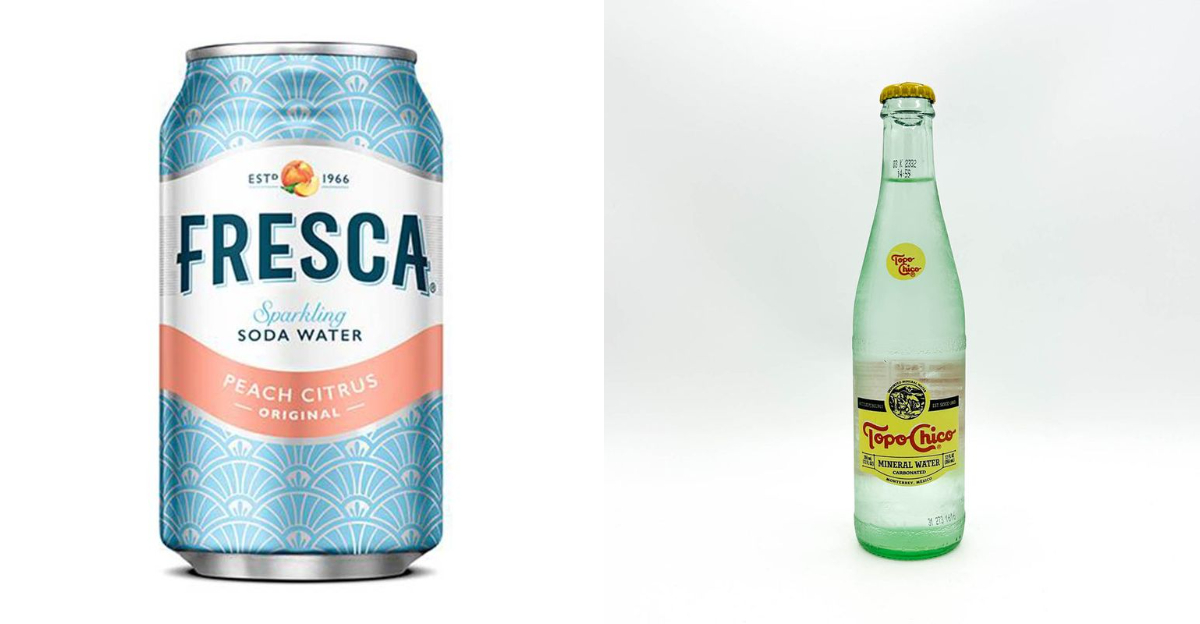9 Sparkling Waters That May Not Be So Healthy & 9 Fizzy Options Worth Sipping

Not all sparkling waters are created equal. Some may dazzle with bubbles but hide ingredients that make nutritionists cringe. Others keep things clean, crisp, and refreshing without the sneaky additives. If you’ve been tossing cans into your cart thinking all fizz is guilt-free, it might be time for a second look. We’re diving into the sparkling water aisle to uncover which ones deserve a spot in your fridge and which are just pretending to be healthy.
Topo Chico’s Mineral Mystery
Mexican-sourced Topo Chico boasts a cult following for its aggressive bubbles, but fans might want to pause before their next sip. Testing revealed some of the highest PFAS levels among sparkling waters.
The brand’s distinctive mineral content gives it that signature taste, yet those same natural elements might be carrying unwanted chemicals.
Mineral water sounds healthy until you realize those minerals might come with unwelcome additions from the source.
Perrier’s Problematic Packaging
French elegance in a bottle doesn’t guarantee purity. Perrier’s iconic green glass houses naturally carbonated mineral water that’s been under scrutiny for potential PFAS contamination.
The brand’s sophisticated image masks concerns about its manufacturing process.
While the water itself comes from a protected source in France, questions remain about how it’s processed and packaged. That distinctive mineral taste might come with more than just the advertised benefits.
Polar’s Concerning Chemicals
Family-owned Polar might seem like a trustworthy choice, but its Natural Seltzer line hasn’t escaped PFAS concerns. The century-old Massachusetts company produces beverages that taste clean and crisp.
Unfortunately, testing suggests otherwise. Their commitment to quality hasn’t prevented questionable chemicals from appearing in their products.
The brand’s wide distribution means these potentially problematic drinks are reaching millions of households nationwide.
Canada Dry’s Deceptive Marketing
Canada Dry’s sparkling seltzer waters market themselves as a clean alternative to their ginger ale, but consumer testing tells a different story.
PFAS has been detected in these seemingly innocent bubbles. The brand’s trusted household name gives consumers a false sense of security.
Their seltzers contain no obvious red-flag ingredients on the label, making the presence of forever chemicals even more concerning for regular drinkers who believe they’re making a healthy choice.
Bubly’s Blackberry Betrayal
PepsiCo’s colorful Bubly line caught consumers’ attention with playful marketing and zero calories. Sadly, some flavors like Blackberry have shown up positive for PFAS in independent testing.
The brand doesn’t add sweeteners, but apparently adds other concerning compounds.
Those cute cans with punny messages don’t mention the potential health impacts of their manufacturing process. The fruity scent that hits your nose might be masking questionable quality standards.
Poland Spring’s Zesty Problem
Nestlé’s Poland Spring Zesty Lime might wake up your taste buds, but it could also introduce unwanted chemicals to your body.
Consumer watchdogs have flagged this brand for potential PFAS contamination. The “natural spring water” source doesn’t guarantee a pure final product.
Manufacturing processes can introduce forever chemicals even when the water source starts clean. Those refreshing bubbles might come with an unwelcome side of industrial compounds.
Fresca’s Flavor Fakery
Fresca markets itself as sparkling soda water, but don’t be fooled by the light, refreshing taste. Unlike true sparkling waters, Fresca contains artificial sweeteners and questionable “natural flavors.”
The zero-calorie promise comes at a chemical cost. Those mysterious “natural flavors” on the ingredient list can hide dozens of undisclosed compounds.
The grapefruit-like taste doesn’t come from actual fruit but from a laboratory-created flavor profile.
Liquid D**th’s Sweet Deception
Punk rock marketing and edgy branding can’t hide Liquid D**th’s flavored sparkling waters’ not-so-healthy ingredients.
The brand adds agave sweetener and other additives to their flavored varieties. Their plain water might be “murder your thirst” pure, but the flavored options aren’t.
That skull-adorned can might look rebellious, but adding sweeteners puts these drinks closer to soda territory than true sparkling water.
The brand’s eco-friendly aluminum packaging doesn’t make up for questionable ingredients.
Spindrift’s Real Fruit Advantage
Finally, a sparkling water that keeps it real! Spindrift stands out by using actual squeezed fruit instead of mysterious “natural flavors.” Each can contains 10% real fruit juice or puree.
The ingredient list reads like something you could make in your kitchen. Those few calories (usually under 15 per can) come from actual fruit, not artificial sweeteners or additives.
The slightly cloudy appearance proves you’re drinking something with genuine ingredients rather than clear chemical concoctions.
Waterloo’s Clean Credentials
Waterloo brings bold flavors without the baggage of questionable ingredients. Their sparkling waters consistently test negative for PFAS while delivering vibrant taste profiles that don’t taste artificial.
The brand prioritizes both flavor and purity. Their carbonation level hits the sweet spot. It’s strong enough to satisfy but not so aggressive it burns your throat.
The company’s transparent manufacturing practices and rigorous testing protocols make these colorful cans a guilt-free choice.
AHA’s Caffeine-Optional Kick
Coca-Cola’s AHA offers something unique in the sparkling water world – select flavors with added caffeine for a gentle energy boost. Their testing shows minimal PFAS levels, making them a safer choice.
The flavor combinations are creative without being weird. Options like Citrus + Green Tea provide refreshment with function.
For those avoiding caffeine, plenty of caffeine-free varieties exist, all without artificial sweeteners or preservatives.
Hint Sparkling’s Subtle Sophistication
Hint’s sparkling line delivers exactly what the name promises, just a hint of flavor without sweeteners or preservatives. Their purification process appears to minimize chemical contamination issues found in other brands.
The delicate flavoring satisfies without overwhelming your palate. Perfect for those who find other flavored waters too intense or artificial-tasting.
The brand’s commitment to clean ingredients extends to their manufacturing practices, resulting in a product that tastes as pure as it claims to be.
Zevia’s Stevia-Sweetened Solution
Zevia bridges the gap between sparkling water and soda with their plant-based sweetened beverages.
Unlike artificial sweeteners, stevia comes from actual leaves and doesn’t raise the same health concerns. The zero-calorie promise doesn’t come with chemical baggage.
Their sparkling water line offers a slightly sweeter option for those transitioning away from soda. The clean ingredient list avoids artificial colors and flavors while still delivering satisfying taste.
Nixie’s Zero Sugar Satisfaction
Nixie has quietly become a favorite among health-conscious consumers looking for clean sparkling options. Their zero-sugar sodas use organic ingredients and natural flavors without artificial sweeteners.
The brand’s commitment to organic certification means stricter standards for ingredients.
Their watermelon mint and lime ginger flavors offer sophisticated taste combinations that feel grown-up compared to typical soda flavors.
The light carbonation complements rather than overwhelms the subtle flavor notes.
Virgil’s Craft Soda Alternative
Virgil’s Zero Sugar line reimagines classic soda flavors without the sugar crash afterward. Using stevia and erythritol (natural sweeteners), they create nostalgic tastes without artificial ingredients.
The root beer and cream soda varieties satisfy cravings for something sweet without chemical aftertastes.
While technically not sparkling water, these beverages offer a healthier fizzy option for those who find plain sparkling water too boring.
The craft brewing approach results in more complex flavor profiles than typical diet sodas.
OLIPOP’s Gut-Friendly Goodness
OLIPOP revolutionizes sparkling beverages with their prebiotic-packed formulas that support digestive health. Each can contains plant fiber and botanical extracts that feed beneficial gut bacteria.
The nostalgic flavors like vintage cola and classic root beer satisfy soda cravings.
With just 2-5 grams of sugar per can (compared to 39g in regular soda), these sparkling treats deliver function without excess sweetness.
The slight cloudiness comes from actual ingredients rather than artificial colors.
Poppi’s Prebiotic Revolution
Poppi transforms apple cider vinegar (ACV) into a delicious sparkling prebiotic soda that’s actually enjoyable to drink.
Each can contains a tablespoon of ACV for digestive benefits without the harsh vinegar taste. The light sweetness comes from minimal added fruit juice.
With just 5g of sugar or less per can, these fizzy drinks deliver gut-supporting benefits in flavors like strawberry lemon and raspberry rose. The colorful packaging matches the bright, clean flavors inside.
